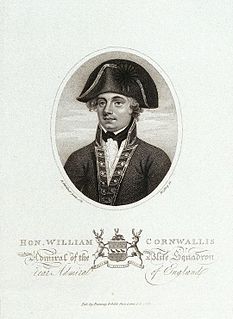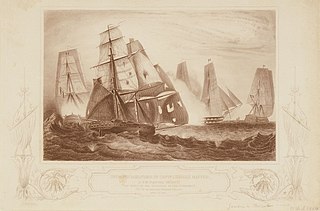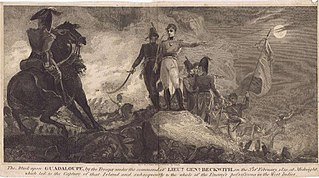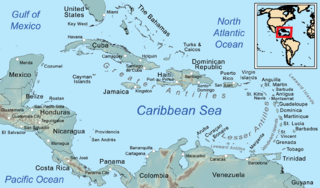
The War of the First Coalition is the traditional name of the wars that several European powers fought between 1792 and 1797 against the French First Republic. Despite the collective strength of these nations compared with France, they were not really allied and fought without much apparent coordination or agreement. Each power had its eye on a different part of France it wanted to appropriate after a French defeat, which never occurred.

The Battle of the Saintes, or Battle of Dominica, was an important naval battle in the Caribbean between the British and the French that took place 9 April 1782 – 12 April 1782, during the American Revolutionary War. The British fleet under Admiral Sir George Rodney defeated a French fleet under the Comte de Grasse, forcing the French and Spanish to abandon a planned invasion of Jamaica.
The 63rd Regiment of Foot, was a British Army regiment, raised in 1756. Under the Childers Reforms it amalgamated with the 96th Regiment of Foot to form the Manchester Regiment in 1881.

Admiral Sir William Cornwallis, was a Royal Navy officer. He was the brother of Charles Cornwallis, the 1st Marquess Cornwallis, British commander at the siege of Yorktown. Cornwallis took part in a number of decisive battles including the Siege of Louisbourg in 1758 and the Battle of the Saintes but is best known as a friend of Lord Nelson and as the commander-in-chief of the Channel Fleet during the Napoleonic Wars. He is depicted in the Horatio Hornblower novel, Hornblower and the Hotspur.
74 Battery is one of the three equipment Batteries in 47th Regiment Royal Artillery and is based in Horne Barracks, Larkhill. The Battery has existed in many forms throughout its history and has been part of several different Royal Artillery units, operating several different pieces of equipment. In 2017 it transferred from the command of 1st Intelligence, Surveillance and Reconnaissance Brigade to 47th Regiment RA, part of Joint Helicopter Command, where it will operate the Thales Watchkeeper WK450 unmanned air system.

The Siege of Fort St Philip took place in 1756 during the Seven Years' War.

The invasion of Martinique of 1809 was a successful British amphibious operation against the French West Indian island of Martinique that took place between 30 January and 24 February 1809 during the West Indies Campaign 1804–1810 of the Napoleonic Wars. Martinique, like nearby Guadeloupe, was a major threat to British trade in the Caribbean, providing a sheltered base from which privateers and French Navy warships could raid British shipping and disrupt the trade routes that maintained the British economy. The islands also provided a focus for larger scale French operations in the region and in the autumn of 1808, following the Spanish alliance with Britain, the Admiralty decided to order a British squadron to neutralise the threat, beginning with Martinique.

Troude's expedition to the Caribbean was a naval operation by a French force under Commodore Amable-Gilles Troude during the Napoleonic Wars. The French squadron departed from Lorient in February 1809 in an attempt to reach and resupply the island colony of Martinique in the Caribbean Sea, then under invasion from a British expeditionary force. The force arrived much too late to affect the outcome of the successful invasion and took shelter from a British squadron in the Îles des Saintes, where they were blockaded by part of the British invasion fleet, led by Vice-Admiral Sir Alexander Cochrane. Two weeks after the French ships arrived, British troops invaded and captured the Saintes, constructing mortar batteries to bombard the French squadron. With his position unsustainable, Commodore Troude decided to break out.

The Action of 22 January 1809 was a minor naval engagement fought off the Caribbean island of Guadeloupe during the Napoleonic Wars. The action was fought as part of the blockade of Guadeloupe and neighbouring Martinique by a large British Royal Navy squadron, which was seeking to cut the islands off from contact and supplies from France by preventing the passage of shipping from Europe to the islands. The British blockade was part of their preparation for planned invasions during the next year.
The Action of 10 February 1809 was a minor naval engagement of the Napoleonic Wars, in which a British Royal Navy squadron chased and captured the French frigate Junon in the Caribbean Sea. Junon was on a mission to carry trade goods from the Îles des Saintes near Guadeloupe back to France and was part of a succession of French warships sent during 1808 and the early months of 1809 in an effort to break the British blockade of the French Caribbean, which was destroying the economies and morale of the islands. Having landed supplies, Junon's return cargo was intended to improve the economic situation on Guadeloupe with much needed oceanic trade.

Great Britain was one of the major participants in the Seven Years' War which lasted between 1754 and 1763, although warfare in the European Theatre involving countries other than Britain and France only commenced in 1756. Britain emerged from the war as the world's leading colonial power, having gained a number of new territories at the Treaty of Paris in 1763 and established itself as the world's pre-eminent naval power.

Roquebert's expedition to the Caribbean, was an unsuccessful operation by a French naval squadron to transport supplies to Guadeloupe in December 1809 at the height of the Napoleonic Wars. Over the previous year, British Royal Navy squadrons had isolated and defeated the French Caribbean colonies one by one, until by the autumn Guadeloupe was the only colony remaining in French hands. Cut off from the rest of the world by British blockade squadrons that intercepted all ships coming to or from the island, Guadeloupe was in a desperate situation, facing economic collapse, food shortages and social upheaval, as well as the impending threat of British invasion. In an effort to reinforce and resupply the colony, the French government sent four vessels to the West Indies in November 1809 under Commodore François Roquebert. Two of the ships were 20-gun flûtes carrying supplies and troops. The two others were 40-gun frigates, ordered to protect the storeships on their journey from the British forces operating off both the French and Guadeloupe coasts.
The Annus Mirabilis of 1759 was a string of notable British victories over French-led opponents during the Seven Years' War.

The Invasion of Guadeloupe was a British amphibious operation fought between 28 January and 6 February 1810 over control of the Caribbean island of Guadeloupe during the Napoleonic Wars. The island was the final remaining French colony in the Americas, following the systematic invasion and capture of the others during 1809 by British forces. During the Napoleonic Wars, the French colonies had provided protected harbours for French privateers and warships, which could prey on the numerous British trade routes in the Caribbean and then return to the colonies before British warships could react. In response, the British instituted a blockade of the islands, stationing ships off every port and seizing any vessel that tried to enter or leave. With trade and communication made dangerous by the British blockade squadrons, the economies and morale of the French colonies began to collapse, and in the summer of 1808 desperate messages were sent to France requesting helping.

A British invasion of Martinique took place in January 1759 when a large amphibious force under Peregrine Hopson landed on the French-held island of Martinique and unsuccessfully tried to capture it during the Seven Years' War. Cannon fire from the British fleet was ineffective against the fortress at Fort-Royal due to its location high on the cliffs, and there were no suitable landing places nearby. Unknown to the British commanders, French governor Francis de Beauharnais had not been resupplied for some months, and even a brief siege would have led to the fort's capitulation. However, Moore and Hopson decided instead to investigate the possibility of attacking Martinique's main commercial port, Saint-Pierre. After a desultory naval bombardment on 19 January that again had little effect on the port's defences, they withdrew, and decided instead to attack Guadeloupe, home to a significant body of French privateers. The expedition was successful at Guadeloupe, which surrendered to them in May 1759. In 1762 a British force captured Martinique.

The Franco-American alliance was the 1778 alliance between the Kingdom of France and the United States during the American Revolutionary War. Formalized in the 1778 Treaty of Alliance, it was a military pact in which the French provided many supplies for the Americans. The Netherlands and Spain later joined as allies of France; Britain had no European allies. The French alliance was possible once the Americans captured a British invasion army at Saratoga in October 1777, demonstrating the viability of the American cause. The alliance became controversial after 1793 when Britain and Revolutionary France again went to war and the U.S. declared itself neutral. Relations between France and the United States worsened as the latter became closer to Britain in the Jay Treaty of 1795, leading to an undeclared Quasi War. The alliance was defunct by 1794 and formally ended in 1800.
Lieutenant-General Richard Stovin was a British Army officer during the late eighteenth and early nineteenth centuries. He originally joined the army as an ensign in 1780, and saw service in the American War of Independence, where he may have been taken prisoner after the Battle of Yorktown. After the outbreak of the French Revolutionary Wars, he saw service with a force sent to invade French colonies in the Caribbean, and was taken prisoner in 1794 at Guadeloupe. Released after two years in captivity, he later commanded his regiment in the Netherlands, in the Anglo-Russian invasion of Holland of 1799, and on garrison duties in the Mediterranean and in India. In the War of 1812 he was appointed to command a division in the forces in Canada, where an island in the St. Lawrence river was named after him.












